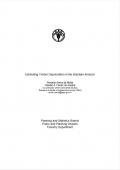The study provides stakeholders with an indication of the true magnitude of the economic and natural capital costs associated with agricultural commodity production and presents a framework that can be used to measure the net environmental benefits associated with different agricultural management practices.
To achieve this objective, Trucost has worked with FAO on two different types of analysis, utilising both Trucost data and models, as well as FAO data, to deliver:
- A global, commodity-based “materiality” approach to assess the natural capital impacts caused by the production of four crops—maize, rice, soybean and wheat—and four livestock commodities—beef, cattle milk, pork and poultry.
- A set of four case studies that focus on different agri-commodities, exploring the trade-offs that exist between adopting different farming practices, including:
It is hoped that the outputs of this analysis will further accelerate business’ uptake of a monetary approach that supports the integration of natural capital costs into mainstream business decisionmaking and operations. Furthermore, the practical case studies aim to demonstrate an approach that assesses the natural capital cost of different management options and how this can be used to support better policy and optimize production.

